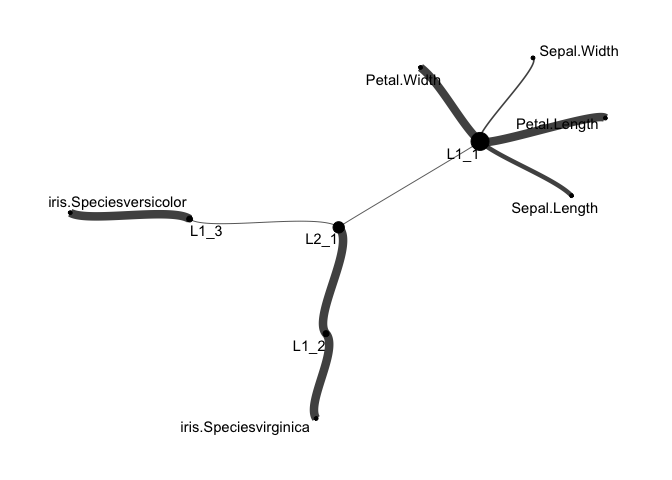Total correlation explanation is method for discovering latent structure
in high dimensional data. Total correlation explanation has been
implemented in Python as CorEx and related modules
(https://github.com/gregversteeg/CorEx). The initial aim of rcorex is
to implement Total Correlation Explanation in the R statistical
software, specifically to replicate the functionality of the BioCorEx
Python module ( https://github.com/gregversteeg/bio_corex ) which is
designed to be suitable for biomedical datasets. This is implemented in
the biocorex() command.
The theoretical framework behind the CorEx and Bio CorEx Python modules are laid out in the following academic papers:
- Discovering Structure in High-Dimensional Data Through Correlation Explanation
- Maximally Informative Hierarchical Representions of High-Dimensional Data
- Comprehensive discovery of subsample gene expression components by information explanation: therapeutic implications in cancer
rcorex can be installed from Github:
# install.packages("remotes")
remotes::install_github("jpkrooney/rcorex")To fit a CorEx model in rcorex we can use the biocorex() command.
biocorex() accepts a data.frame or a matrix as input, however as with
the Python implementation of Bio CorEx, all variables must have the same
data-type and currently only “discrete” or “gaussian” data are allowed
as marginal descriptions, which apply to all columns.
library(rcorex)
# make a small dataset
df1 <- matrix(c(0,0,0,0,0,
0,0,0,1,1,
1,1,1,0,0,
1,1,1,1,1), ncol=5, byrow = TRUE)
# fit biocorex
set.seed(1234)
fit1 <- biocorex(df1, n_hidden = 2, dim_hidden = 2, marginal_description = "discrete", logpx_method = "pycorex")
#> Calculating single iteration of corex
plot(fit1)summary(fit1)
#> rcorex model call:
#> biocorex(data = df1, n_hidden = 2, dim_hidden = 2, marginal_description = "discrete",
#> logpx_method = "pycorex")
#> Data dimensions: 4 samples (rows) by 5 variables (columns).
#> Latent variable parameters: rcorex searched for 2 hidden variables with 2 possible states.
#> Model outcome state: Converged
#> Numer of iterations performed: 16
#> Total TCS at final iteration: 2.0769
# What was the total correlation for each hidden dimension ?
fit1$tcs
#> [1] 1.3847955 0.6921477
# Which variables were clustered together?
fit1$clusters
#> [1] 0 0 0 1 1
# Which labels were assigned to each row of data for hidden cluster 1?
fit1$labels[, 1]
#> [1] 1 1 0 0
# And for hidden cluster 2?
fit1$labels[, 2]
#> [1] 0 1 0 1rcorex can search for hierarchical structure in data by using the
labels output from an rcorex object as the input to the next layer in
the hierarchy. This is shown in the following example using R’s inbuilt
iris dataset.
library(rcorex)
library(ggraph)
#> Loading required package: ggplot2
set.seed(1234)
# Load iris dataset
data("iris")
# Need to convert species factor variable to indicator variables
iris <- data.frame(iris , model.matrix(~iris$Species)[,2:3])
iris$Species <- NULL
# fit first layer of CorEx
layer1 <- biocorex(iris, 3, 2, marginal_description = "gaussian", repeats = 5, logpx_method = "pycorex")
#> Calculating repeat # 1
#> Calculating repeat # 2
#> Calculating repeat # 3
#> Calculating repeat # 4
#> Calculating repeat # 5
#> 3 out of 5 repeat runs of biocorex converged.
#> Returning biocorex with highest TC of all converged runs - unconverged runs will not be included in comparison of runs.Note the use of the repeats = 5 argument to biocorex. This acts to
run biocorex not once, but 5 times and biocorex automatically
selects the run which produces the maximal TC to return to the user
(unless the return_all_runs argument is set to TRUE).
We can then use the labels from layer1 as the input for a second layer
of CorEx to discover hierarchical structure. Note that the value used
for n_hidden should be lower in the second layer than it was in the
first.
# fit second layer of CorEx
layer2 <- biocorex(layer1$labels, 1,2, marginal_description = "discrete", repeats = 5, logpx_method = "pycorex")
#> Calculating repeat # 1
#> Calculating repeat # 2
#> Calculating repeat # 3
#> Calculating repeat # 4
#> Calculating repeat # 5
#> 5 out of 5 repeat runs of biocorex converged.
#> Returning biocorex with highest TC of all converged runs - unconverged runs will not be included in comparison of runs.
# make a network tidygraph of hierarchical layers
g_hier <- make_corex_tidygraph( list(layer1, layer2))
# Plot network graph of hierarchical layers
ggraph(g_hier, layout = "fr") +
geom_node_point(aes(size = node_size), show.legend = FALSE) +
geom_edge_hive(aes(width = thickness), alpha = 0.75, show.legend = FALSE) +
scale_edge_width(range = c(0.3, 3)) +
geom_node_text(aes(label = names), repel = TRUE) +
theme_graph()Additional hierarchical layers can be identified in larger datasets.
If you find rcorex useful in academic work please cite the package as
follows:
citation("rcorex")
#>
#> To cite rcorex in publications use:
#>
#> Rooney JPK (2021). rcorex: Discover latent structure in high
#> dimensional data. R package version 0.2.3.
#> https://github.com/jpkrooney/rcorex. doi: 10.5281/zenodo.5235604.
#>
#> A BibTeX entry for LaTeX users is
#>
#> @Manual{,
#> title = {rcorex: Discover latent structure in high dimensional data.},
#> author = {James PK Rooney},
#> year = {2021},
#> note = {R package version 0.2.3},
#> doi = {10.5281/zenodo.5235604},
#> url = {https://github.com/jpkrooney/rcorex},
#> }
